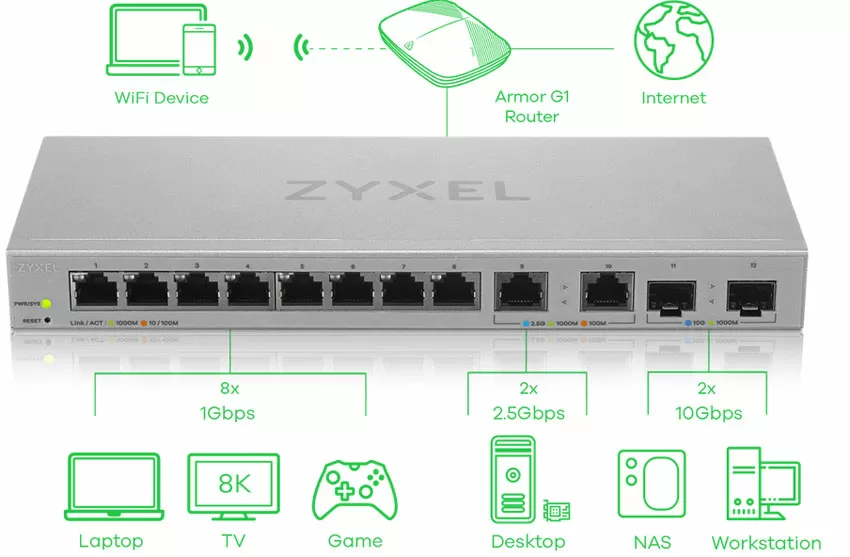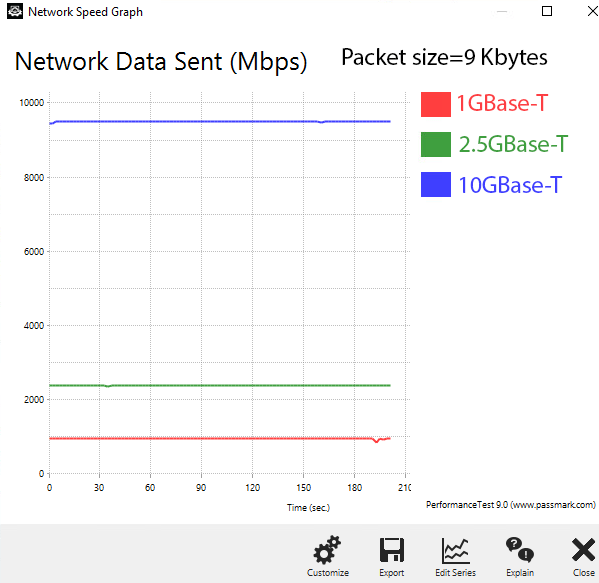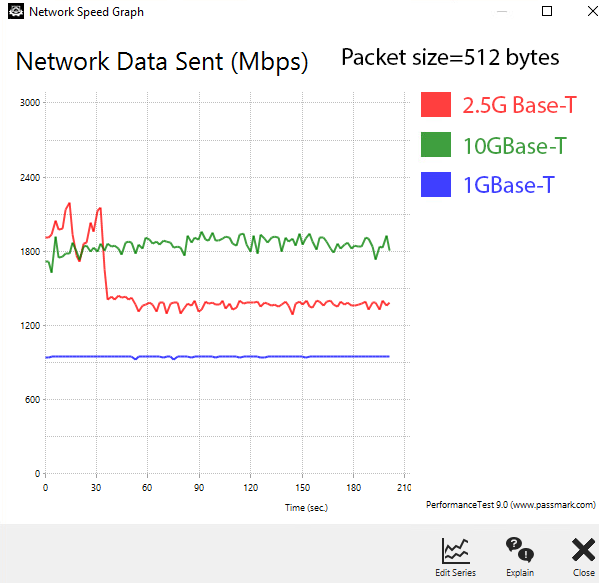Review of Zyxel XGS1210-12 and XGS1010-12 multi-gigabit switches with a speed of 1/2.5/10 Gbps
And you know that 10 Gigabit Ethernet was introduced back in 2006, and was created mainly for file servers of small companies, and after a decade and a half, it still remains a novelty for many consumers in the small business environment. The reason for the banality is simple: there were no speeds for which you can invest in 10-gigabit switches and expensive cable infrastructure. The concept of using personal laptops, wireless MFPs, smartphones and all-in-ones required the development of wireless networks, and gigabit wire, as a rule, was enough for everyone.
Progress did not stand still, and in order to somehow get things off the ground, in 2015, network equipment manufacturers proposed intermediate Nbase-T (802.3bz) standards with speeds of 2.5 Gbps and 5 Gbps ... They solved the main problem holding back the spread of 10-Gigabit networks in small businesses: they allowed the use of CAT-5 cable, that is, a conventional twisted pair cable with the same connectors as for 1-Gigabit networks. In fact, manufacturers offered to use existing cables for new fast networks, and from about 2015-2017, affordable network controllers based on Aquantia and Broadcom chips with support for 10GBase-T and NBase-T began to appear, which have found application in top-end computers for enthusiasts and NAS-ah. But, again, these decisions did not cause any excitement.
|
Standard
| Transmission of the number of bits per cycle |
Requirements for the type of cable for connection at a distance of up to 50 meters |
Requirements for the type of cable for connection at a distance of up to 100 meters |
Bandwidth, MHz
|
|
10Base-T |
1 |
CAT3 |
CAT3 |
16 |
|
100Base-TX
|
3.2 |
CAT5 |
CAT5 |
100
|
|
1000Base-T
|
4 |
CAT5 |
CAT5 |
100 |
|
2.5GBase-T |
6.25 |
CAT5 |
CAT5E |
100 |
|
5GBase-T |
6.25 |
CAT5 |
CAT6 |
250 |
|
10GBase-T |
6.25 |
CAT6 |
CAT6A |
500 |
The thing is that by the time Nbase-T equipment went on sale, those users who were interested in high LAN speeds had long switched to 10 Gbps, using an optical or copper cable, and to turn on 2500BASE-X networks into projects, a driver was needed, and it appeared only at the beginning of 2020.
This driver is the 802.11ac and 802.11ax wireless access points, whose aggregate throughput has long exceeded 1 Gb/s and rested on the possibility of wired connection. Today, the availability of fast modern wireless access to the network has already become mandatory not only for commercial, but also for public facilities: in offices, in hospitals, on trains, in the MFC, in conference rooms and on pleasure boats, where 802.11 access points were installed yesterday ac, today they are being changed to 802.11ax. And here the 2500BASE-X standard acts as an ideal cure for low speed: you do not need to rearrange the cable and crimp chips: just change the access point and switch - and you will get a 2.5 Gbps interconnect speed under the same conditions. Good competitive advantage, isn't it?
XGS1210-12 and XGS1010-12
Of course, distribution switches need to support such high speeds, and Zyxel has recently launched new versatile budget switch models that combine 1, 2.5 and 10 Gbps ports in a single chassis. As conceived by the manufacturer, one such switch is installed on an entire facility: whether it be a conference room, a waiting room or a hotel complex. A pair of 10 Gigabit SFP + slots are used for connecting via optics to a trunk cable or storage system, two 2.5 Gigabit RJ45 ports - for access points or workstations, well, and 8 ordinary 1 Gigabit connections - for distributing traffic to workplaces or other connections.

I have only one question: where in 2020 did Zyxel see NAS with SFP + slots? All 10-gigabit models have long used copper cables, and optics are only used in corporate rack-mounted machines. Naturally, gaming motherboards, on which workstations and specialized boards are assembled, also use the copper standard, and roughly speaking, 10-Gigabit optics can be found today, perhaps, on Supermicro boards ... Although ... if the client is not shy about gesturing, then 10-gigabit network adapter with one SFP + port at eBay can be purchased 15$. Naturally, it will be a used board like Mellanox ConnectX-2, which has served for 10 years in the data center, and will still serve you :)
Zyxel has a bunch of multi-gigabit switches: the core-level XS1930 managed, the XGS1210-12 Web-managed for the distribution network, the XGS1010-12 unmanaged for the desktop. Moreover, the latter has a hardware-wired QoS function for 1 Gigabit ports:

- 4 ports are low priority
- 2 ports - medium
- 2 ports - high priority
The PoE function is still available only in XS1930-12HP, which seems strange to me: since we are talking about Wi-Fi access points, PoE should be everywhere, and perhaps it will appear a little later, but now we will look at the design of switches...
Both models in question, the XGS1010-12 and XGS1210-12, have the same metal case, designed to be mounted on a table: there are no rack mounts either in the base package or in the form of accessories. Both switches use passive cooling, and after removing the case cover, we see a massive heatsink plate that removes heat from four chips.
The switching fabric is represented by the Realtek RTL9302B processor, which has a frequency of 800 MHz and supports up to 16 ports. The total switching performance is 66 Gbps, that is, the physical capabilities of the ports are fully disclosed. A single DDR3 NANYA NT5CC64M16GP chip with a volume of 128 Megabytes is used as a buffer: a decent amount for a 12-port switch.
The following chips are used to work with the physical layer of the connection: one Realtek RTL8231 for 8 1GBase-T ports and two Realtek RTL8226, one for each 2.5 Gigabit port. SFP + slots do not require the use of PHY, and this provides significant savings. By the way, Zyxel currently offers only the following types of SFP + optical transceivers.
|
10 Gigabit Zyxel SFP + Modules
|
SFP10G-SR |
SFP10G-LR |
|
Connector |
Duplex LC
|
Duplex LC
|
|
Wavelength, nm
|
850 |
1310 |
|
Maximum connection length, Km
|
0.3
|
10 |
|
Fiber type
|
Multi Mode
|
Single Mode
|
Those who want to use 10GBase-T SFP + modules can use compatible devices.
In terms of circuitry, the XGS1010-12 and XGS1210-12 models are absolutely identical, so the only difference is the control of the older model through the web interface, which we will now get acquainted with.
Web interface
Before us is the well-known Zyxel platform, which is used in the XGS switches of the initial series. The settings here are the minimum, only the most necessary. One port can be included only in several VLANs, and preset groups are available for port trunking:
- Ports 1, 2, 3, 4
- Ports 5 & 6 Ports 7 & 8 Ports 9 & 10
- As you can see, it is not possible to combine SFP + ports into LAGs, but hardly anyone will need it.
When configuring QoS, you can use queues based on port number, as well as using the IEEE 802.1p algorithm.
I would also like to note the support for IGMP Snoop for multicast traffic and the ability to disable STP. Zyxel periodically updates the firmware for its entry-level switches, but the changes are so minor that they may never be updated.
Testing
To test the Zyxel XGS1210-12 switch, we use the following configuration stand:
- AMD EPYC 7552P
- ASRockRack EPYCD8-2T
- 32GB RAM
- Intel X520
- Intel X550-T2
- Transcend SSD230S
- VMWare ESXi 6.7U3
- Windows Server 2019 x64
- PassMark Performance Test 9.0
During testing, network cards were connected in a loop through a switch, measuring the speed of work with themselves. The switches have a very small buffer that flattens the performance on all major interfaces, and in the most benign conditions we see throughput at the level of the declared characteristics.

If you do not take the measurement error, then here we are dealing with port restrictions. It's a different story when we reduce the packet size to 512 bytes.

On 1 Gigabit ports, everything is very good, and even fine: we are still dealing with modern Realtek logic with a switching capacity of 49 million packets/sec. Here we have a throughput of 945 Mbps, which is great. But then miracles begin: 2.5-Gigabit ports with speeds up to 2100 Mbps are already facing a shortage of buffer size and sink their speed up to 1400 Mbps, and 10-Gigabit ports completely overload the stack, maintaining a stable speed range of 1900-2000 Mbps. In general, everything is as it should be for an entry-level switch.
Conclusions
Retail prices for the switches are $ 180 for the unmanaged XGS1010-12 and $ 260 for the web-managed XGS1210-12. When integrating into an office network, it makes sense to take the XGS1010-12 just as a device with 10G and 2.5G ports, and put all the controls "above" him on a more advanced switch. This switch is devoid of any drawbacks, and if you are satisfied with the port configuration, you can take it! The XGS1210-12 model is actually asked for in a WLAN installation, but the lack of PoE is seriously embarrassing, so I can't woo this switch as a platform for modern access points.
Of course, a full-fledged switch for 12 multi-gigabit ports, and even with PoE, such as the Zyxel XS1930-12HP, costs like a cast iron bridge: about $ 1000 retail, and given that most wired connections in modern networks are still 1 -gigabit, and real 10G bandwidth is rarely required even in small business data centers, such multi-gigabit solutions with 1G/2.5G/10G ports are our future for the coming years, which will be provided by 5G and Wi-Fi 6 technologies.
Mikhail Degtyarev (aka LIKE OFF)
07/16/2020













